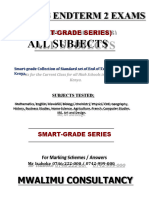History Form 2 Marking Scheme
Uploaded by
imamaijumaHistory Form 2 Marking Scheme
Uploaded by
imamaijumaST.
BERNARD KAKURIKIT SECONDARY SCHOOL
FORM ONE
HISTORY AND GOVERNMENT
TERM 1 END TERM EXAM – 2023
MARKING SCHEME
SECTION A (20MKS)
Answer all questions in this section.
1. Define the government. (2mks)
Refers to the political and administrative structure of a state.
2. Name two oral sources of information on history and government. (2mks)
Legends
Myths
Songs
Proverbs
3. Define the term citizenship. (2mks)
The legal right that an individual has to belong to a given country or nation.
4. Identify two main methods of trade. (2mks)
Currency trade
Barter trade
6. Name the highest court in Kenya today. (1mk)
The supreme court
7. Name two groups of the Luo who migrated and settled into Kenya. (2mks)
Joka-jok
Joka-owiny
9. Name two Christian missionaries at work in Kenya by the 19th century. (2mks)
Ludwig craft
Johann Rebmann
10. Give one environmental reason for the migration of Cushite into Kenya. (1mk)
Natural calamities eg floods
12. Apart from Fort Ternan, name two other sites out of Kenya. (2mks)
Omo valley in Ethiopia
Olduvai gorge in Tanzania
14. State one source of information on history and government (1mk)
Linguistics
Archaeology
15. Who is the current cabinet secretary of education. (1mk)
Ezekiel Machogu
SECTION B (30mks)
20. (a) State THREE symbols of National unity. (3mks)
National flag
National anthem
National awards
Coat of arms
Loyalty pledge
(b) Discuss SIX factors that promote National unity. (12mks)
Education
National language
The presidency
Political parties
Fair distribution of resources
Equal employment
22. (a) Identify Five animals that were used for transport in the past. (5mks)
Elephants
Water buffalo
Reindeer
Dogs
Camels
Mules
Llamas
(b) Explain the advantages of road transport. (10mks)
Its cheap over short distances.
Faster compared to water and rail.
Roads are flexible.
Reduces the cost of movement.
Cheaper to construct than railways.
23. (a) State the goods that were exchanged during the Trans Saharan trade. (5mks)
Gold
Slaves
Kola nuts
Hides and skins
Ivory
Gum
(b) Identify and explain ways that were used to obtain slaves during the Trans-Atlantic Trade. (10mks)
Selling of domestic slaves in exchange for goods like beads.
Prisoners of war could be sold off.
Porters were sometimes kidnapped, transported and sold off to the Arab traders.
Raiding of villages.
Tax offenders were sold off by the African chiefs.
Through ambushes during hunting, travelling and gardening.
Through intertribal wars.
You might also like
- History Form 2 Question Paper Zeraki Achievers 11.0 - October 2023100% (1)History Form 2 Question Paper Zeraki Achievers 11.0 - October 202311 pages
- Kcse 2024 Paper 1......All Qsns Assignments - Form 3 - c.r.e.No ratings yetKcse 2024 Paper 1......All Qsns Assignments - Form 3 - c.r.e.2 pages
- Socio-Economic and Political Organization of Kenyan Communities in The 19Th Century - Form 1 History NotesNo ratings yetSocio-Economic and Political Organization of Kenyan Communities in The 19Th Century - Form 1 History Notes16 pages
- Kcse 2104 History Paper 2 SECTION A (25 Marks) : Answer Any Three Questions From This SectionNo ratings yetKcse 2104 History Paper 2 SECTION A (25 Marks) : Answer Any Three Questions From This Section2 pages
- Jesus Conflict With The Jewish Religious LeadersNo ratings yetJesus Conflict With The Jewish Religious Leaders22 pages
- Form-2-History-Term-1-2-3-Schemes-of- Work-2025No ratings yetForm-2-History-Term-1-2-3-Schemes-of- Work-20252 pages
- CRE PAPER 2 KCSE 2024. ATTEMPT QSN 1,2,3,4 Assignments - Form 3 - C.R.E.100% (1)CRE PAPER 2 KCSE 2024. ATTEMPT QSN 1,2,3,4 Assignments - Form 3 - C.R.E.2 pages
- Answer All Questions From This Section: AA-14 Form Two History Section A (25marks)100% (1)Answer All Questions From This Section: AA-14 Form Two History Section A (25marks)2 pages
- Kcse History Paper 1 Qustions and AnswersNo ratings yetKcse History Paper 1 Qustions and Answers143 pages
- Political Developments and The Struggle For Independence inNo ratings yetPolitical Developments and The Struggle For Independence in98 pages
- Bible Knowledge - Exam n Answers - MsomiBora.comNo ratings yetBible Knowledge - Exam n Answers - MsomiBora.com8 pages
- Reading John Lara's The Samaritan: Plot Analysis and Characters: A Guide to Reading John Lara's The Samaritan, #1From EverandReading John Lara's The Samaritan: Plot Analysis and Characters: A Guide to Reading John Lara's The Samaritan, #1No ratings yet
- John Lara's The Samaritan: Themes and Elements of Style: A Guide to Reading John Lara's The Samaritan, #2From EverandJohn Lara's The Samaritan: Themes and Elements of Style: A Guide to Reading John Lara's The Samaritan, #2No ratings yet
- Https Retail - Onlinesbi.com Retail Mobilenoupdateguidelines100% (1)Https Retail - Onlinesbi.com Retail Mobilenoupdateguidelines1 page
- International Relations and Diplomacy ISNo ratings yetInternational Relations and Diplomacy IS66 pages
- 2023 Global Construction Costs Database - Sample100% (1)2023 Global Construction Costs Database - Sample21 pages
- The Spread of AI-Generated MisinformationNo ratings yetThe Spread of AI-Generated Misinformation42 pages
- Best 3.1 Sites To Buy Verified Cash App Accounts in This Year100% (3)Best 3.1 Sites To Buy Verified Cash App Accounts in This Year13 pages
- Budget Motivation Speech For Prison ServicesNo ratings yetBudget Motivation Speech For Prison Services9 pages
- Form - A5 - Student - REVISED PS 09012018 PDFNo ratings yetForm - A5 - Student - REVISED PS 09012018 PDF3 pages
- All India Prelims Test Series - 2017: Indian Polity + GeographyNo ratings yetAll India Prelims Test Series - 2017: Indian Polity + Geography11 pages
- Ethical Decision Making For The 21st Century Counselor 1st Edition Sheperis Test Bank100% (1)Ethical Decision Making For The 21st Century Counselor 1st Edition Sheperis Test Bank42 pages

























































































